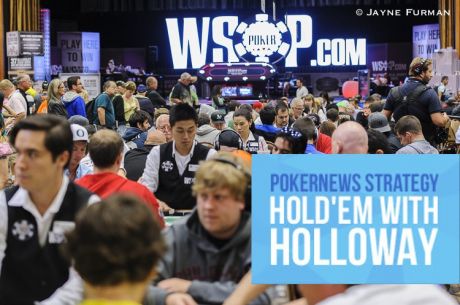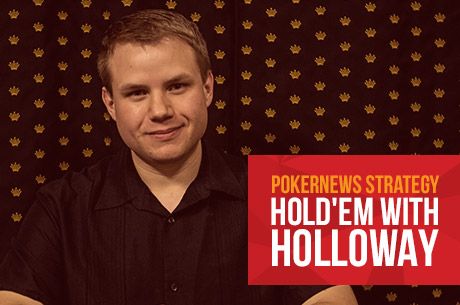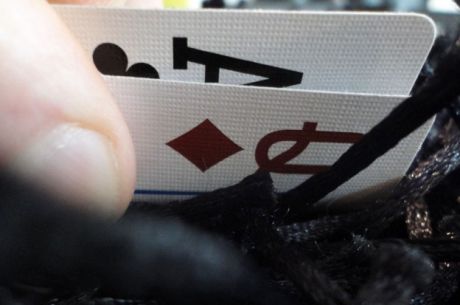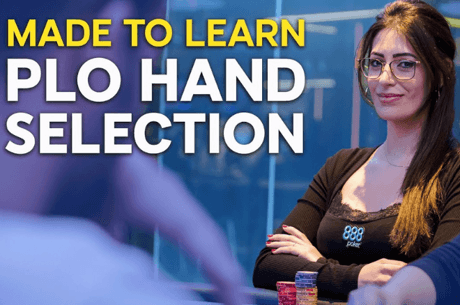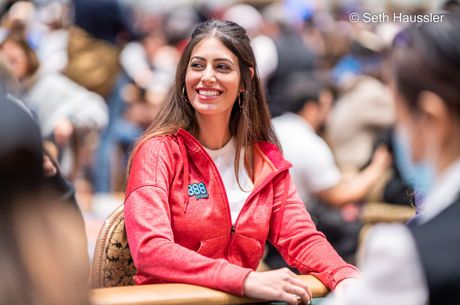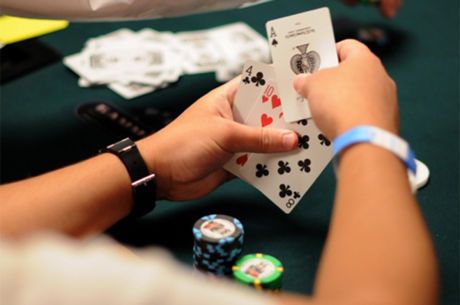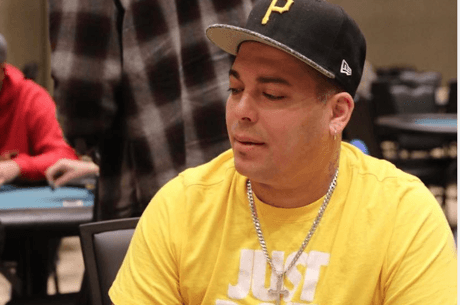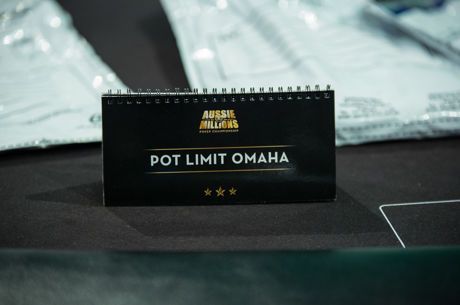Hold��em with Holloway, Vol. 37: Lessons in Pot-Limit Omaha Hi-Low w/ Evan Jarvis
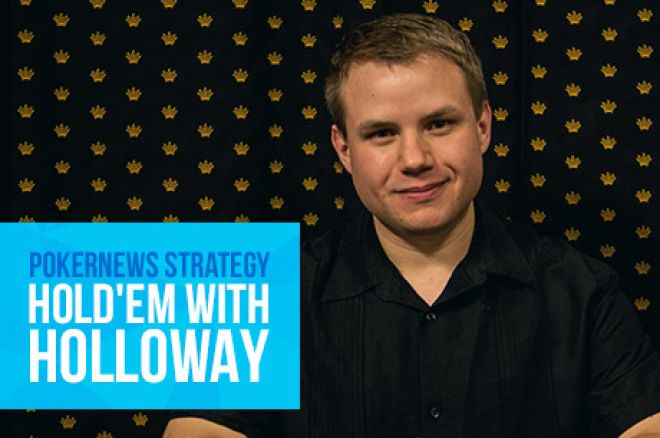
Once again I am going to depart from the title of this column and not focus on no-limit hold��em. Instead, I am going to use this week��s piece to talk about my experience playing Event #49: $1,500 Pot-Limit Omaha Hi-Low Split (8 or Better) at the 2015 World Series of Poker. It did not go well.
The tournament attracted 815 runners and created a prize pool of $1,100,250. I��m by no means a PLO8 expert �� far from it in fact. I��ve got a lot of PLO experience, and have played my fair share of limit Omaha hi-low, but the hybrid version was relatively new to me. As such, I spent some time in the days leading up to the event talking strategy with Gripsed Poker��s Evan Jarvis, who was also planning to play the event.
Based on our discussions, I was feeling confident when I took my seat at noon on Day 1. I planned to play tight, more pots in position, and to draw to the nuts. I busted halfway through Level 2 about 90 minutes into play. I was extremely disappointed, and went back to Jarvis after the tournament (he made Day 2 but failed to cash) to follow-up on a few hands.
I thought it would be educational to share those hands, along with Jarvis�� thoughts, below:
Hand #1: Good Cautious Play or Bad Fold?
Early on, when I had a stack of approximately 6,000, I raised to 200 holding AxAxJ?9?. Three players called, and the flop came down A?10?Kx.
The player in the small blind checked. The player who was in the big blind bet 500, I opted just to call, and another player folded. The small blind got out of the way and the turn card was a blank, totally missing my hand. The big blind bet 1,500 and again I just called. Much to my dismay, the river was also a blank. The big blind bet 2,500 and I reluctantly folded my hand.
My Take: I��m not sure if raising with this hand is wise, but my thinking was that I held two aces and big cards, meaning if the flop came big I stood a chance of winning a monster, and if it came low I could get away cheaply.
Obviously I loved the flop, which gave me top set, as well as straight and flush draws. However, I was taken aback that the big blind led out. He was a tight player, and I immediately pegged him for the flopped straight; hence my cautious play of just calling. This could have been a mistake as I took a cautious line on the remaining two streets, ultimately folding.
Is it possible my opponent had two pair, a lower set, or a flush draw and I folded the winner? Should I have called on the river? To be honest, I��m not sure.
Jarvis�� Take: With this hand I would probably opt to open with a limp if I were to play the hand at all. My intention is to limp-reraise if I can get the majority of my stack in and otherwise look to flop top set or get out. This is definitely not a hand I want to build a big pot with preflop, especially in early position. Aces hold much less value in PLO8 than they do in PLO and even less than in no-limit hold��em.
The power of holding an ace in this game is the ability to make nut flush draws and nut low draws. In this case the suit is to the jack, which isn��t much value. If the hand were suited to the ace or the nine was another Broadway card, I would be much more interested in playing the hand.
After the flop I would play the hand the same way. The turn may be close depending on whether or not you think he will reluctantly pay off the river. If he��s of the nitty variety, I may actually fold the turn to a full-pot bet.
The river is an easy fold, especially in this field there is no hand your opponent can hold except for QxJxXxXx. Players don��t lead out with two pair or sets into multi-way pots unless its their first time playing, which is surprisingly common in this particular WSOP event.
Hand #2: Should I Have Pounded the Turn?
In another hand, this one from Level 2 with my stack around 2,000, I limped from the hijack with 9x6x3x2x and the small blind came along. Rex Clinkscales checked his option from the big blind and the three of us saw a flop of K?A?7?.
After my two opponents checked, I bet 150 with a diamond flush draw and the nut-low draw. Both my opponents called, then all three of us checked the 7? turn. When the J? completed the board on the river, the small blind checked, Clinkscales bet 300, and I had to fold. The small blind then check-raised the pot and Clinkscales released his hand.
My Take: I shouldn��t have even played this hand in the first place. The flop didn��t give me anything but the nut-low draw (and that weak flush draw), and I opted to bet it hoping to build a pot with both my opponents. To that end I was happy to see them call, but not so happy when the turn paired the board. It checked to me, and I can��t help but wonder had I bet pot if both my opponents would have folded. I��m sure I could have pushed them off an ace or king, but if either held a seven I was toast (though I still had the low draw to fall back on).
Instead I opted to take the free card and the river blanked. As you can see from how the hand played out, the small blind was likely sitting with a big hand, so had I pounded the turn I likely would have been out of the tournament. Of course, that��s being results oriented.
Jarvis�� Take: This hand is also pretty marginal, with hands like 6x3x2xXx you need a very specific flop to feel comfortable about your hand, and the big issue is the lack of high-hand potential. You��re basically trying to flop a hand that will win you half the pot. If I��m going to play this hand I��m coming in for a raise.
The flop play is fine, although I may go for a full pot-sized bet. Most of the time in this game if you��re going to bet on the come you want to be betting full pot.
The turn is a card that is unlikely to change much and the blinds are more likely to have sevens in their hand than you are (most hands involving a seven should be folded preflop in this game).
Because of that I think giving up on the hand is perfectly fine. It��s unfortunate that you didn��t catch a card that could win you at least a piece of the pot, but hey, that��s poker.
This game is about scooping people much more than bluffing. In both these spots you got involved with marginal hands that don��t play well multi-way and thus aren��t money makers. The common theme in these hands is not playing two-way hands. In this game you need hands that can scoop the pot.
In Hand #2 we are basically playing a one-way hand going for the low, and in Hand #1 we are actually looking at not even a one-way, but a one-time hand because we��re basically going for top set and nothing else.
Lesson: be more selective.
For more on Jarvis and Gripsed Poker Training, which offers poker strategy, videos, community and more, simply click here. You can also follow Gripsed Poker on Twitter.
Want to stay atop all the latest in the poker world? If so, make sure to get PokerNews updates on your social media outlets. Follow us on Twitter and find us on both Facebook and Google+!
In this Series
- 1 Hold��em with Holloway, Vol. 1: Making Reads and Trusting Them
- 2 Hold��em with Holloway, Vol. 2: Playing in Poker Charity Events
- 3 Hold��em with Holloway, Vol. 3: Throttle Back Before You End Up Punting
- 4 Hold��em with Holloway, Vol. 4: Punish the Satellite Bubble
- 5 Hold��em with Holloway, Vol. 5: What is Proper Accumulator Strategy?
- 6 Hold��em with Holloway, Vol. 6: A Chip and a Chair Story with ��SirWatts��
- 7 Hold��em with Holloway, Vol. 7: 15 Things About Poker I Wish I��d Known Sooner
- 8 Hold��em with Holloway, Vol. 8: Examining the Largest Overlay in Poker History
- 9 Hold��em with Holloway, Vol. 9: Differences Between Rebuys and Reentries
- 10 Hold��em with Holloway, Vol. 10: Five Must-Read Poker Books of 2014
- 11 Hold��em with Holloway, Vol. 11: When Will You Finally Break Through?
- 12 Hold��em with Holloway, Vol. 12: Dealing with a Target on Your Back
- 13 Hold��em with Holloway, Vol. 13: Knowing When to Call It Quits
- 14 Hold��em with Holloway, Vol. 14: Embarking on a Year-Long Weight Loss Journey
- 15 Hold��em with Holloway, Vol. 15: Navigating Multiple Decision Points in a Poker Hand
- 16 Hold��em with Holloway, Vol. 16: Chris Moorman Tells Me How Badly I Play Poker
- 17 Hold��em with Holloway, Vol. 17: Richard ��nutsinho�� Lyndaker on Getting It in Marginal
- 18 Hold��em with Holloway, Vol. 18: Getting Inside the Head of Poker Pro Brian Rast
- 19 Hold��em with Holloway, Vol. 19: Stupid Calls & Lucky Draws in MSPT WI Championship
- 20 Hold��em with Holloway, Vol. 20: Talking Ante-Only Strategy with Greg ��FossilMan�� Raymer
- 21 Hold��em with Holloway, Vol. 21: Contributing to Jonathan Little��s New Book
- 22 Hold��em with Holloway, Vol. 22: Consequences of Acting Out of Turn & Tossing in Chips
- 23 Hold��em with Holloway, Vol. 23: When It Comes to Chops, Do What��s In Your Best Interest
- 24 Hold��em with Holloway, Vol. 24: Accepting Bad Beats & Lessons in Selling Action
- 25 Hold��em with Holloway, Vol. 25: Heinz�� Ace-High Call Shows Why He's a World Champ
- 26 Hold��em with Holloway, Vol. 26: Is Keeping the Short Stack Alive Collusion?
- 27 Hold��em with Holloway, Vol. 27: Great Laydown or Bad Fold on Poker Night in America?
- 28 Hold��em with Holloway, Vol. 28: Calling Hellmuth with Jack-Deuce Offsuit
- 29 Hold��em with Holloway, Vol. 29: The Philosophy of "No-Chop" Chad
- 30 Hold��em with Holloway, Vol. 30: Preparing to Play the World Series of Poker
- 31 Hold��em with Holloway, Vol. 31: Staying on Your Grind at the World Series of Poker
- 32 Hold��em with Holloway, Vol. 32: The Perilous Decision to Call Off with Ace-Queen
- 33 Hold��em with Holloway, Vol. 33: Using Poker Skills in Reality TV Competitions
- 34 Hold��em with Holloway, Vol. 34: Esfandiari Explains How to Recover from Bad Beats
- 35 Hold��em with Holloway, Vol. 35: Tilly vs. Brunson in Super High Roller Cash Game Hand
- 36 Hold��em with Holloway, Vol 36: Unconventional Play Leads to Good WSOP Main Event Start
- 37 Hold��em with Holloway, Vol. 37: Lessons in Pot-Limit Omaha Hi-Low w/ Evan Jarvis
- 38 Hold��em with Holloway, Vol. 38: Things to Say and Do When You Bust a Poker Tournament
- 39 Hold��em with Holloway, Vol. 39: How Much Did I Have to Raise to Get You to Fold?
- 40 Hold��em with Holloway, Vol. 40: Practicing Patience in My Deep PPC Poker Tour Run
- 41 Hold��em with Holloway, Vol. 41: Analyzing a Questionable SHRPO Main Event Hand
- 42 Hold��em with Holloway, Vol. 42: Analyzing the Play of Neymar Jr. at EPT Barcelona
- 43 Hold��em with Holloway, Vol. 43: The Value of a Reliable Poker Reputation
- 44 Hold��em with Holloway, Vol. 44: John ��KasinoKrime�� Beauprez Rips My PLO Game Apart
- 45 Hold��em with Holloway, Vol. 45: Satellite Dilemmas -- To Call or Not to Call
- 46 Hold��em with Holloway, Vol. 46: Seiver Leverages the River in Super High Roller Bowl
- 47 Hold��em with Holloway, Vol. 47: What Untraditional Moves in Poker Might Mean
- 48 Hold��em with Holloway, Vol. 48: Thinking About the Future with Sam Grizzle
- 49 Hold��em with Holloway, Vol. 49: WCOOP Champ ��Coenaldinho7�� Offers Up His Biggest Hands
- 50 Hold��em with Holloway, Vol. 50: The Peril of Shoving Weak Aces
- 51 Hold��em with Holloway, Vol. 51: The Importance of Not Giving Up in Poker Tournaments
- 52 Hold��em with Holloway, Vol. 52: Does Asking ��Check�� Actually Constitute a Check?
- 53 Hold��em with Holloway, Vol. 53: Thomas Cannuli Impresses Even After Main Event Bustout
- 54 Hold��em with Holloway, Vol. 54: Dealers Aren��t Always Right
- 55 Hold��em with Holloway, Vol. 55: Don��t Get Married to Pocket Aces
- 56 Hold��em with Holloway, Vol. 56: Bazeley��s Survival Instinct Leads to Continued Success
- 57 Hold��em with Holloway, Vol. 57: Playing ��Deuces Wild�� on the European Poker Tour
- 58 Hold��em with Holloway, Vol. 58: The Wildest Hand in European Poker Tour History
- 59 Hold��em with Holloway, Vol. 59: Death, Zombies & Spending Time w/Phil Hellmuth
- 60 Hold��em with Holloway, Vol. 60: How the Unstoppable Fedor Holz Managed to Win Again
- 61 Hold��em with Holloway, Vol. 61: Lessons To Be Learned When You Hit the Big Stage
- 62 Hold��em with Holloway, Vol. 62: Steve O��Dwyer Explains the ��Oreo Cookie Tell��
- 63 Hold��em with Holloway, Vol. 63: What Would Happen to a Chip Stack If a November Niner Died?
- 64 Hold��em with Holloway, Vol. 64: Forgetting One Chip -- Should It Still Be an All-In Bet?
- 65 Hold��em with Holloway, Vol. 65: Todd ��sharkslayerrr�� Breyfogle on Bankroll Management
- 66 Hold��em with Holloway, Vol. 66: Cash Game Pro Daniel Arfin Offers Sound Bankroll Advice
- 67 Hold��em with Holloway, Vol. 67: Honeyman Plays Kings to Keep in Opponent��s Bluff Range
- 68 Hold��em with Holloway, Vol. 68: Why Do I Even Bother Drinking at the Poker Table?
- 69 Hold��em with Holloway, Vol. 69: Is Your Favorite Poker Pro Left- or Right-Handed?
- 70 Hold��em with Holloway, Vol. 70: In Order to Live You Have to Be Willing to Die
- 71 Hold��em with Holloway, Vol. 71: How to Amass a Big Stack Early in a Poker Tournament
- 72 Hold��em with Holloway, Vol. 72: Answering User-Submitted Poker Scenarios
- 73 Hold��em with Holloway, Vol. 73: Saying Goodbye with a Top Five List
- 74 Hold'em with Holloway, Vol. 74: We're Back, Baby!
- 75 Hold'em with Holloway, Vol. 75: Jivkov on Exploiting Capped Ranges
- 76 Hold��em with Holloway, Vol. 76: Matt Bretzfield Gets Tricky With Aces
- 77 Hold'em with Holloway, Vol. 77: Joseph Cheong Gets Crazy with a Pair of Ladies
- 78 Hold'em with Holloway, Vol. 78: Wyoming Poker Action & Wild South Dakota Hand
- 79 Hold'em with Holloway, Vol. 79: Calling Controversy at WinStar
- 80 Hold'em with Holloway, Vol. 80: Going for Value with Matt Hunt
- 81 Hold'em with Holloway, Vol. 81: Bracelet Winner Ryan Leng on Bad Call
- 82 Hold'em with Holloway, Vol. 82: Romeopro33 Recounts XL Eclipse Victory
- 83 Hold'em with Holloway, Vol. 83: Men The Master Doesn't Get Paid
- 84 Hold'em with Holloway, Vol. 84: Harman Hits Back-to-Back Miracle Turns
- 85 Hold'em with Holloway, Vol. 85: Jamie Kerstetter on Dealing with Bounties
- 86 Hold'em with Holloway, Vol. 86: Matt Stout Develops a Limp Dynamic
- 87 Hold'em with Holloway, Vol. 87: Matt Alexander Caught in Between w/ Two Red Aces
- 88 Hold'em with Holloway, Vol. 88: John Beauprez on Why He Folded a Set of Jacks
- 89 Hold'em with Holloway, Vol. 89: Alex Aqel Lets Opponent Hang Himself with Aces
- 90 Hold'em with Holloway, Vol. 90: David Peters Makes Beastly Call Against Will Givens
- 91 Hold'em with Holloway, Vol. 91: Poker Lessons from a Game of Risk
- 92 Hold'em with Holloway, Vol. 92: My Upstuck Diagnosis by the CLC Squad
- 93 Hold'em with Holloway, Vol. 93: Alex Foxen Coolers Nick Petrangelo in SHRB
- 94 Hold'em with Holloway, Vol. 94: My $25,000 PSPC Experience at 2019 PCA
- 95 Hold'em with Holloway, Vol. 95: The Equity of Leveraging Time Extensions
- 96 Hold'em with Holloway, Vol. 96: Dan O'Brien on Developing Healthy Routines
- 97 Hold'em with Holloway, Vol. 97: Big Hands From the WSOP-C Potawatomi
- 98 Hold'em with Holloway, Vol. 98: Simon Deadman Rips Apart My NLH Tourney Play
- 99 Hold'em with Holloway, Vol. 99: Shoving 10-6 Smack Dab Into Pocket Aces
- 100 Hold'em with Holloway, Vol. 100: The Revived Re-Entries Debate

